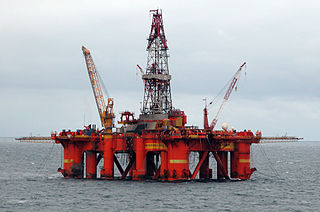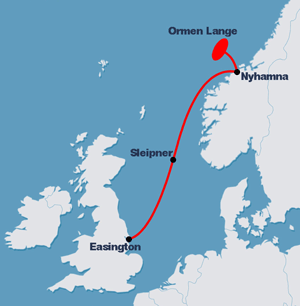
Offshore construction is the installation of structures and facilities in a marine environment, usually for the production and transmission of electricity, oil, gas and other resources. It is also called maritime engineering.

A winch is a mechanical device that is used to pull in or let out or otherwise adjust the tension of a rope or wire rope.

Dynamic positioning (DP) is a computer-controlled system to automatically maintain a vessel's position and heading by using its own propellers and thrusters. Position reference sensors, combined with wind sensors, motion sensors and gyrocompasses, provide information to the computer pertaining to the vessel's position and the magnitude and direction of environmental forces affecting its position. Examples of vessel types that employ DP include ships and semi-submersible mobile offshore drilling units (MODU), oceanographic research vessels, cable layer ships and cruise ships.

A crane is a type of machine, generally equipped with a hoist rope, wire ropes or chains, and sheaves, that can be used both to lift and lower materials and to move them horizontally. It is mainly used for lifting heavy objects and transporting them to other places. The device uses one or more simple machines to create mechanical advantage and thus move loads beyond the normal capability of a human. Cranes are commonly employed in transportation for the loading and unloading of freight, in construction for the movement of materials, and in manufacturing for the assembling of heavy equipment.

A semi-submersible platform is a specialised marine vessel used in offshore roles including as offshore drilling rigs, safety vessels, oil production platforms, and heavy lift cranes. They have good ship stability and seakeeping, better than drillships.

A diving bell is a rigid chamber used to transport divers from the surface to depth and back in open water, usually for the purpose of performing underwater work. The most common types are the open-bottomed wet bell and the closed bell, which can maintain an internal pressure greater than the external ambient. Diving bells are usually suspended by a cable, and lifted and lowered by a winch from a surface support platform. Unlike a submersible, the diving bell is not designed to move under the control of its occupants, or to operate independently of its launch and recovery system.

A diving support vessel is a ship that is used as a floating base for professional diving projects. Basic requirements are the ability to keep station accurately and reliably throughout a diving operation, often in close proximity to drilling or production platforms, for positioning to degrade slowly enough in deteriorating conditions to recover divers without excessive risk, and to carry the necessary support equipment for the mode of diving to be used.

The Saipem 7000 is the world's third largest semi-submersible crane vessel, after the SSCV Sleipnir and the SSCV Thialf. It is owned by the oil and gas industry contractor Saipem S.p.A.

Marine salvage is the process of recovering a ship and its cargo after a shipwreck or other maritime casualty. Salvage may encompass towing, lifting a vessel, or effecting repairs to a ship. Protecting the coastal environment from oil spillages or other contaminants from a modern ship can also be a motivator, as oil, cargo, and other pollutants can easily leak from a wreck.
MacGregor Pusnes formerly known as Aker Pusnes, Aker Kværner Pusnes and Maritime Pusnes, established in 1875, is a designer and supplier of all types of deck machinery and mooring systems for marine and offshore applications. In addition, Aker Pusnes has developed and supplied bow loading and offloading systems for both simple and sophisticated operations offshore. The company is a subsidiary of Aker Solutions and located on Tromøya island near the city of Arendal in Aust-Agder county, Norway.
A drill string compensator decreases the influence of the heave of a drilling vessel on the drill bit. Drill string compensators are also known under the more general name: heave compensator. Drill string compensators are used onboard drill ships and semi-submersible drill rigs. There are two major types of drill string compensators:

A crane vessel, crane ship, crane barge, or floating crane is a ship with a crane specialized in lifting heavy loads, typically exceeding 1,500 t for modern ships. The largest crane vessels are used for offshore construction.

Commercial offshore diving, sometimes shortened to just offshore diving, generally refers to the branch of commercial diving, with divers working in support of the exploration and production sector of the oil and gas industry in places such as the Gulf of Mexico in the United States, the North Sea in the United Kingdom and Norway, and along the coast of Brazil. The work in this area of the industry includes maintenance of oil platforms and the building of underwater structures. In this context "offshore" implies that the diving work is done outside of national boundaries. Technically it also refers to any diving done in the international offshore waters outside of the territorial waters of a state, where national legislation does not apply. Most commercial offshore diving is in the Exclusive Economic Zone of a state, and much of it is outside the territorial waters. Offshore diving beyond the EEZ does also occur, and is often for scientific purposes.
Passive heave compensation is a technique used to reduce the influence of waves upon lifting and drilling operations. A simple passive heave compensator (PHC) is a soft spring which utilizes spring isolation to reduce transmissibility to less than 1. PHC differs from AHC by not consuming external power.

Wire rope spooling technology is the technology to prevent wire rope getting snagged when spooled, especially in multiple layers on a drum.

A submarine pipeline is a pipeline that is laid on the seabed or below it inside a trench. In some cases, the pipeline is mostly on-land but in places it crosses water expanses, such as small seas, straits and rivers. Submarine pipelines are used primarily to carry oil or gas, but transportation of water is also important. A distinction is sometimes made between a flowline and a pipeline. The former is an intrafield pipeline, in the sense that it is used to connect subsea wellheads, manifolds and the platform within a particular development field. The latter, sometimes referred to as an export pipeline, is used to bring the resource to shore. Sizeable pipeline construction projects need to take into account many factors, such as the offshore ecology, geohazards and environmental loading – they are often undertaken by multidisciplinary, international teams.

Lift-on/lift-off ships are cargo ships with on-board cranes to load and unload cargo. Ships with cranes or other cargo handling equipment on-board are also termed geared vessels.
A seabed tractor is a type of remotely operated underwater vehicle. They can be used for submarine cable laying or burial of cables or pipelines. This type of vehicle consists of a tracked Crawler excavator device, configured for the task. It is controlled from the vessel by an umbilical cable. Operating seabed tractors is similar to operating Remotely operated underwater vehicles. The seabed tractor operator drives the unit as if on board, using cameras on the unit for visual feedback.
Balanced heave compensation (BHC) is a heave compensation technology engaging the principle of a balanced-arm lamp for offshore motion compensation.
Heave compensation is move compensator technology applied to minimizing the vertical movement of a load supported by lifting gear mounted on a heaving platform. Techniques include active heave compensation and passive heave compensation—the two traditional types of heave compensation—as well as balanced heave compensation. Devices that perform heave compensation are known as heave compensators.













